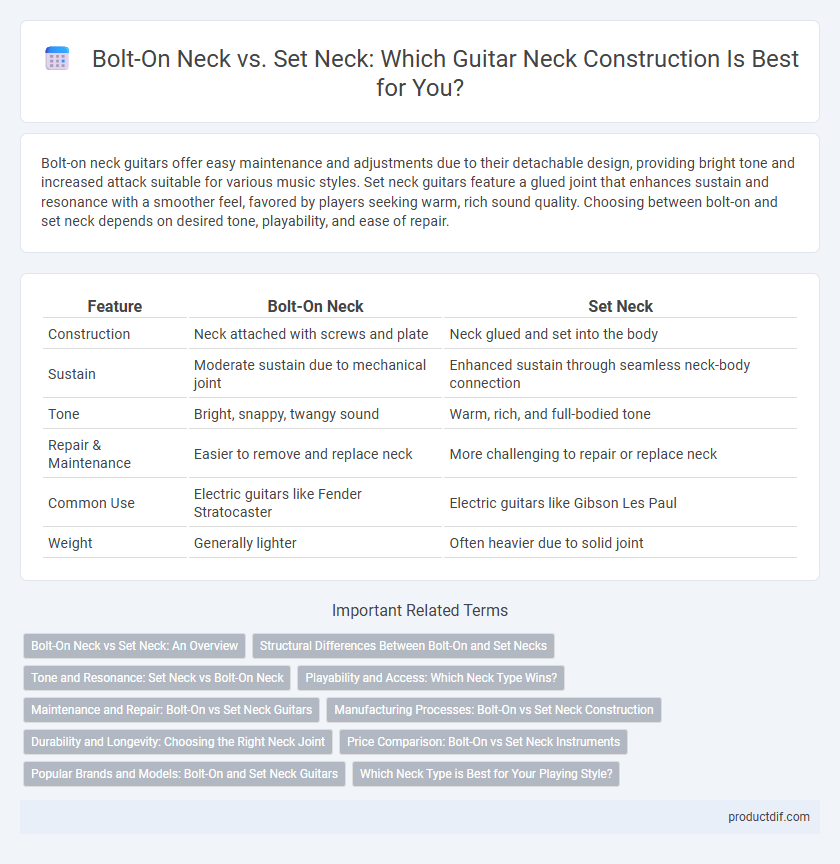Bolt-on neck guitars offer easy maintenance and adjustments due to their detachable design, providing bright tone and increased attack suitable for various music styles. Set neck guitars feature a glued joint that enhances sustain and resonance with a smoother feel, favored by players seeking warm, rich sound quality. Choosing between bolt-on and set neck depends on desired tone, playability, and ease of repair.
Table of Comparison
| Feature | Bolt-On Neck | Set Neck |
|---|---|---|
| Construction | Neck attached with screws and plate | Neck glued and set into the body |
| Sustain | Moderate sustain due to mechanical joint | Enhanced sustain through seamless neck-body connection |
| Tone | Bright, snappy, twangy sound | Warm, rich, and full-bodied tone |
| Repair & Maintenance | Easier to remove and replace neck | More challenging to repair or replace neck |
| Common Use | Electric guitars like Fender Stratocaster | Electric guitars like Gibson Les Paul |
| Weight | Generally lighter | Often heavier due to solid joint |
Bolt-On Neck vs Set Neck: An Overview
Bolt-on neck construction features a neck attached to the guitar body with bolts or screws, offering easier repair and customization compared to set necks, which are glued for improved sustain and resonance. Bolt-on necks provide a brighter tone and sharper attack, favored in genres like rock and metal, while set necks deliver warmer, fuller sounds commonly associated with jazz and blues. The choice between bolt-on and set neck affects playability, tonal characteristics, and maintenance, making it essential for musicians to consider their stylistic needs and instrument longevity.
Structural Differences Between Bolt-On and Set Necks
Bolt-on necks attach to the guitar body using screws and a metal plate, allowing easier neck removal and adjustment while offering a brighter tone with increased attack. Set necks are glued into a precisely routed pocket, creating a seamless joint that enhances sustain and provides a warmer, fuller sound. The choice between bolt-on and set necks impacts the guitar's structural stability, repairability, and tonal characteristics significantly.
Tone and Resonance: Set Neck vs Bolt-On Neck
Set neck guitars generally produce warmer tones and enhanced sustain due to the glued joint, which facilitates better vibration transfer between the neck and body. Bolt-on necks offer a snappier attack and brighter tonal response, attributed to the mechanical fastening that slightly reduces resonance compared to set necks. The choice between set neck and bolt-on neck significantly influences the instrument's resonance and overall tonal character.
Playability and Access: Which Neck Type Wins?
Bolt-on neck guitars offer easier access to the upper frets due to their thinner neck joints, enhancing playability for lead guitarists who frequently navigate higher registers. Set neck guitars provide a smoother heel transition, resulting in a more comfortable grip and better sustain, favored by rhythm players. When prioritizing playability and upper-fret access, bolt-on necks typically win, while set necks excel in overall comfort and tone stability.
Maintenance and Repair: Bolt-On vs Set Neck Guitars
Bolt-on neck guitars offer easier maintenance and repair because the neck can be removed and replaced without affecting the guitar body, making adjustments and modifications straightforward. Set neck guitars, with the neck glued into the body, require more complex repairs that often demand professional luthier services and can be costly or risky if the glue joint fails. Bolt-on designs provide greater flexibility for customization and quick fixes, while set necks typically enhance sustain and tone at the expense of repair convenience.
Manufacturing Processes: Bolt-On vs Set Neck Construction
Bolt-on neck construction involves attaching the guitar neck to the body using screws or bolts, allowing easier assembly and replacement, which reduces manufacturing time and costs. Set neck construction requires the neck to be glued into a precisely fitted pocket in the guitar body, demanding more labor-intensive craftsmanship and curing time for the adhesive. This difference in manufacturing processes impacts the guitar's structural integrity, tonal characteristics, and production scalability.
Durability and Longevity: Choosing the Right Neck Joint
Bolt-on necks offer easier repairs and replacements, enhancing long-term playability, while set necks provide stronger adhesion that typically results in better sustain and structural integrity. Durability in set neck joints usually surpasses bolt-on designs due to the glued joint's resistance to movement and environmental changes. Guitarists prioritizing maintenance ease might prefer bolt-on necks, whereas those valuing longevity and tone stability often choose set neck construction.
Price Comparison: Bolt-On vs Set Neck Instruments
Bolt-on neck guitars typically offer a more affordable price point due to simpler manufacturing and easier assembly processes, making them popular among entry-level and mid-range instruments. Set neck guitars generally command higher prices because of the labor-intensive glued joint, which enhances sustain and tonal quality, appealing to professional players and collectors. The price difference reflects both construction costs and the perceived value of improved resonance in set neck models.
Popular Brands and Models: Bolt-On and Set Neck Guitars
Fender is renowned for its bolt-on neck guitars, such as the Stratocaster and Telecaster, delivering bright tones and easy neck repairs preferred by rock and blues players. Gibson dominates the set neck segment with iconic models like the Les Paul and SG, offering enhanced sustain and a warmer sound favored in jazz and hard rock. Brands like Ibanez and ESP also incorporate both neck types in models that cater to diverse playing styles and genres, balancing playability and tonal characteristics.
Which Neck Type is Best for Your Playing Style?
Bolt-on necks offer brighter tones and easier repairs, making them ideal for players seeking versatility and quick maintenance, common in genres like rock and funk. Set necks provide superior sustain and a warmer, more resonant sound favored in blues and jazz styles, appealing to players prioritizing rich tonal depth. Choosing between bolt-on and set neck depends on whether you prioritize tonal brightness and ease of adjustment or sustain and a fuller sound for your playing style.
Bolt-on neck vs Set neck Infographic

 productdif.com
productdif.com